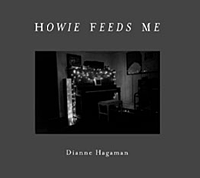SUFFUSING AND SUSTAINING:
A Note on Dianne Hagaman’s Work
BY MICHAEL JOYCE
Howie Feeds Me is a haunting, and lushly original work which begs for and encourages the deepest sorts of conversation while simultaneously beckoning us to a suffusing and sustaining solitude. The work topples the tunnel of light which the computer too often forces upon us, turning the tunnel instead into a river, a suffusion, a permeation, an illumination flowing over screen, the viewer’s body and room alike, a spilling out of light and life echoed, repeated and anticipated within its constituent images.
It may strike some viewers as curious that Dianne Hagaman terms Howie Feeds Me a sonnet sequence, yet nothing could be more apt. In the sonnet’s formal confines the sonneteers traditionally found manifold spaces, unending inward unfoldings, a linguistic origami for the play of language and human emotion. The captioned and moveable loops of Howie Feeds Me similarly evoke the interleaved balancing of forces which scholars traditionally talk about in sonnets. In traditional sonnets the eight and six or twelve and two of the poem’s larger rhythms work not “against" (the typical, wrongful word) but in conjunction (or disjunction, these are after all the same thing) with the inner rhythms of rhymes and enjambments and caesurae and so on. So too for Hagaman the larger rhythms and interplay of her collected images here — diurnal, quotidian, mortal — join and sever and link and juxtapose.
The sonnet has, of course, traditionally been a lovers’ form, a sounding of the heart in both senses of that word. While there are (blessedly) no sounds in this work, there are many moments — a laughing group poised at a dinner table in festive light, a snowy landscape under streetlights — when you could swear that the screen whispers to you. Yet that other kind of sounding, the plumbing of depths, whether heart or river, is everywhere here. Light rather than lead plumbs the full flow of love and life here.
The oddly displaced, and thus pleasing, syntax of Hagaman’s evocative captions dislodges the way we look at language (literally) but also of course how we look at all, and especially at the contraposed images. Hagaman’s gift for contraposing and juxtaposition is something that the photographers, new media practioners, artists, and others who were fortunate enough to experience her privately circulated and legendary “hypertext quilt” will recognize. That previous work’s monumental virtual space (five by five feet viewed through the screen’s mere fifteen or seventeen inch lens) juxtaposed images of Native Americans in Seattle’s Pioneer Square with images of them in their native grounds. Viewers scrolling over the surface of the virtual fabric stitched a richly compelling, even heart-wrenching, meditation on those large words culture, humanity, and civilization as seen through the small moments of real people’s lives.
Howie Feeds Me operates similarly. Anyone who has spent time with Dianne while she is working knows that she is nearly always making images. She shoots constantly (almost always with high speed film and great depth of field), the Leica a natural and unobtrusive choreography, a loving gesture, as ready as her ready laughter, its rhythm like breathing. Hagaman’s art is thus truly paradoxical, an unchosen choosing, an unmediated mediation, the distinctly feminine interface which feminist media theorist Heidi Tikka sees as both a flow and a kind of skin, “a porous and breathing surface through which a variety of exchange takes place.”
This is a genuinely interactive work, not just in the technological sense, but also and more importantly (as the title suggests) in the intellectual, spiritual, erotic, and sustaining senses. Which is to say our senses. It is literally sustaining work, one which feeds the eye and heart and soul and mind. The nurture of its title is everywhere evident and mutual, being fed is being, an action, not what happens to one. Every screen feeds its viewer-reader. The effect of the work is finally neither scenic nor poetic but erotic, a touching and feeding both. This kind of loving interaction requires acquaintance in the deeper sense of living with and through, inhabitation, how we are only sometimes acquainted with our own eyes and what they say to us, the language they use a little displaced, dislodged.
Howie Feeds Me is a true love story and a story of true love and truly a (love) story. Its moveable loops are the essence of narrative, the mergings and permeations, the odd angles reconciling into longer rhythms and repetitions, light into shadow giving forth light. There is a story here, and it is one we make in our seeing through (a phrase I love for its doubleness: the lens and the persistence, what a marriage is, what a word or an image is). The resolutions are multiple, every ending an opening. Hagaman’s looped stories, not only accumulate around the main screen’s wonderfully Oulipian sonnet of song titles, but also play against the more verse-like captioned loops, recapitulating the simultaneous oppositions, the push-pull of the heart’s flow, weaving these rhythms into a delicate, luminous and powerfully symphonic work.
Michael Joyce teaches at Vassar College and is the author of many well-known hypertexts, including afternoon: a story and Twilight, and many works in print, including the novel Liam’s Going and the book of essays Of Two Minds: Hypertext Pedagogy and Poetics.






